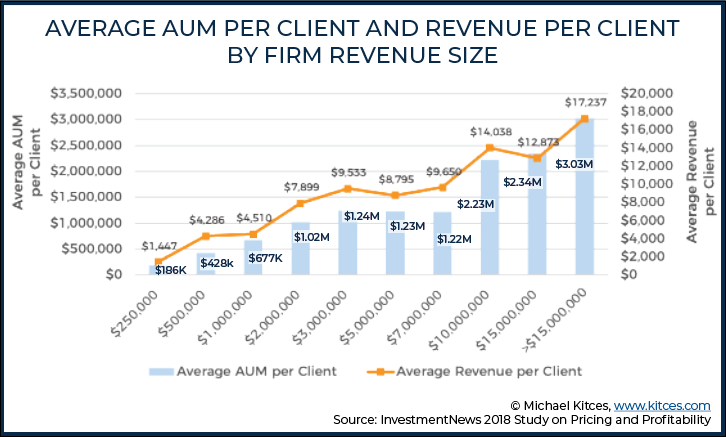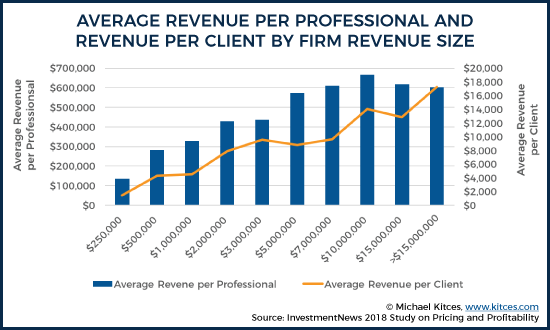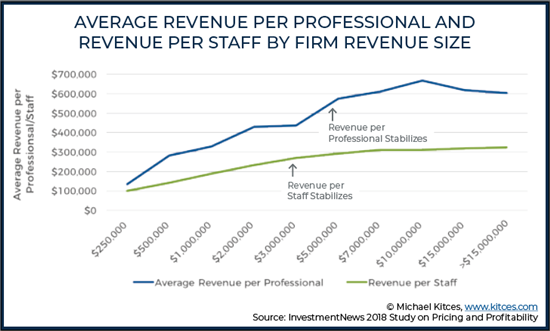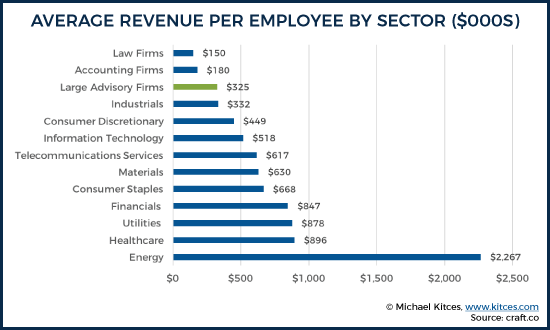Executive Summary
As advisory firms grow, it’s crucial to both measure and manage the productivity of the firm. At the individual level, productivity is typically measured by evaluating the amount of time it takes to complete various key tasks. At the firm level, it’s measured through key “revenue ratios” that become Key Performance Indicators (KPIs) for the entire business.
The first key revenue ratio that all advisory firms should measure is revenue per client – literally, by dividing the total revenue of the firm by the number of clients. The significance of revenue/client is that it is the most straightforward way to understand an advisory firm’s “typical” clientele, to immediately identify clients that may unprofitable (i.e., significantly below-average revenue/client), and to determine which clients are so far above the firm’s average that it may be worthwhile to segment them and then provide additional services to them. In addition, given that the typical solo advisor only ever has the capacity for 50-100 clients in total, understanding the advisor’s revenue/client provides an indication of his/her maximum earning potential as well (at least until/unless lower-revenue clients are replaced by higher-revenue ones!).
As advisory firms grow, and become multi-advisor, so too does the next revenue ratio for productivity shift, from revenue/client (for an individual advisor’s clients), to revenue per advisor themselves. By measuring revenue/advisor, it’s quickly possible to see which advisors in the firm are more efficiently servicing their clients (and the associated revenue), by literally handling more revenue per advisor. On the other hand, extreme deviations in revenue/advisor can also provide an indicator of not just efficiency and productivity, but significant over- or under-servicing of clients as well.
And for the largest advisory firms, the key measure of productivity becomes revenue per employee, the most straightforward way to quantify, in the aggregate, how much staff it takes across the enterprise to service each segment of the firm’s clients and revenue.
In turn, advisory firms that measure these three Key Performance Indicators of advisor productivity can then evaluate how they compare to other firms at a similar size, using industry benchmarking studies. Which actually show that, when measured on these key productivity measures, advisory firms may not actually benefit much at all from growing larger and gaining economies of scale, as larger firms tend to attract more affluent clients (with higher revenue/client) that demand additional services which in turn fully offset any size-based efficiencies!
The bottom line, though, is simply to understand that as advisory firms grow as businesses, it is feasible to benchmark the productivity of the firm in the aggregate… and then take the necessary steps to manage it accordingly!
The Importance Of Generating Enough Revenue Per Client For Solo Advisors
If there’s one factor that ultimately drives the financial success of any business, it’s the amount of revenue it generates from each of its users, customers, or clients. After all, at the most basic level, if each person who patronizes the business doesn’t generate enough revenue to cover the costs of providing the product or delivering the services, the business simply doesn’t work.
In fact, the whole basis of “cost-plus” pricing is to determine the raw cost of a product or service, including the overhead to create and deliver and service it, along with what it takes to market and sell it, and then add a little markup to it (for the profit opportunity of the business), and make that the price
In the context of being a financial advisor, though, not every client typically buys the exact same service at the exact same (fixed) cost. Instead, the amount of revenue generated from each client will vary, based on the size of each transaction (for a commission-based model), the size of each portfolio (for an AUM model), or the complexity/depth of each financial plan (for a fee-for-service model). Which is important because it means that, while with typical cost-plus pricing, the price of a product, by definition, is set at a level that will make it profitable (and hopefully, still priced reasonably enough that people actually want to buy it!), when it comes to financial advisors, it is the norm that not every client will be equally profitable.
With a fee-for-service model where pricing is tied most directly to the time the advisor will spend on the client, this is less of an issue, because the price of the services tends to align well because it is either billed directly by the hour, or at least is priced based on the estimated number of hours to deliver the advice.
But in a commission-based or AUM model, in particular, the amount of revenue per client can vary, substantially, from one client to the next (most commonly based on how affluent the client is, which impacts the size of the portfolio or the amount of insurance or investment products they purchase), even as the cost to service each client – which is driven primarily by the staff TIME it takes to service the client – is relatively consistent to maintain each relationship.
Which in turn is why it’s so common to segment clients in a financial advisory firm by the revenue they generate. Because adding in additional services or other value-adds is a way to effectively reinvest a portion of the proceeds of an otherwise-highly-profitable client (ostensibly in the hopes of increasing the retention of a slightly-less-but-still-profitable client in the process).
But the starting point of it all is simply to understand what the average revenue per client is in the first place. Which both makes it possible to then identify clients who are materially above the average (i.e., the clients who are either most profitable and perhaps deserve some additional services to justify their fees) or below the average (i.e., the least profitable clients who should probably be terminated, or at least “graduated” to another advisor for whom they’re a better fit).
And given that the typical financial advisor can only handle about 100 real financial planning relationships, understanding the average revenue per client also provides an indication of the “maximum” revenue that advisor can ever earn (e.g., $3,000/client every year means a maximum of $300,000/year in revenue for the practice!), beyond which growth is only possible by either hiring another advisor… or finding more affluent clientele who can pay a higher amount of annual revenue in the first place.
In fact, industry benchmarking data shows that average revenue/client is a key to growing the size of an advisory firm, as firms that grow tend to move “upmarket” and attract more affluent clients who generate a higher level of revenue/client, and the higher level of revenue/client allows the firm to provide more and deeper services that attract an even more affluent clientele with higher-still revenue per client! Accordingly, the latest 2018 Investment News Study on Profitability and Pricing shows a nearly perfect trend between the overall revenue and size of the firm and the average amount of revenue it generates per client!

The bottom line, though, is simply to recognize that when the maximum number of clients is constrained by a human capacity on relationships… the single greatest driver of an advisor’s long-term growth potential is the average revenue of the clients he/she serves. And when an advisor reaches capacity, the only way to increase his/her personal revenue is to increase the average revenue per client!
Managing Productivity In Mid-Sized Firms By Measuring Revenue Per Advisor
While for an individual advisor, the primary constraint is the amount of revenue per client (which at a maximum client capacity, dictates the maximum revenue he/she can earn), when it comes to multi-advisor firms, the second key metric becomes the amount of revenue managed per advisor. In essence, revenue per advisor is the core measure of advisor “productivity,” literally quantifying the amount of revenue that the typical advisor is responsible for generating and/or managing.
Of course, as noted earlier, financial advisors are typically more constrained by the sheer number of client relationships they’re responsible for (and have to actively engage with), as opposed to the amount of client revenue, per se.
Nonetheless, to the extent that more affluent clients typically want and demand more services, which therefore necessitates the advisor working with fewer of them at a time, assessing revenue per advisor in a firm is still a remarkably effective proxy for evaluating the advisor’s overall productivity in supporting clients.
In fact, when viewing the average revenue per advisor in firms of various sizes in the latest 2018 Investment News Study of Pricing and Profitability, it’s notable that while revenue per client tends to increase steadily as advisory firms grow larger, the revenue per advisor does not! Instead, once advisory firms reach about $3M to $5M of revenue, and a critical mass of advisors and firm infrastructure, the productivity per advisor of advisory firms largely levels off. From there, any increases in the average revenue per client are generally offset by the fact that the advisor needs to manage fewer clients in order to provide adequate services to them!

As the results show, advisory firms tend to level off at a threshold of about $600,000 of revenue per advisor. Notably, though, this measure includes revenue across all the advisor professionals of the firm, including both senior/lead advisors, and also service and support advisors. Which means in practice, many of these firms are likely supporting $1.2M of client revenue with a 2-person team, or nearly $2M of revenue with a 3-person advisor team.
Nonetheless, the point remains that the overall productivity of how many advisors it takes to service a certain number of clients (and amount of revenue they provide) is remarkably consistent once advisory firms grow and scale to a certain size. For which any other mid-to-large-sized advisory firm can then assess the productivity of its own teams, to determine whether they are more or less productive than the average.
Notably, advisor productivity as measured by revenue per advisor also functions as an indirect measure of the advisor’s knowledge capital, as more educated, trained, and skilled advisors are generally capable of working with more affluent clients and/or generating a higher level of revenue on the time they work in the business. Either by literally billing at a higher rate, or more commonly by being able to manage and service a similar number of clients who are somewhat more affluent, with the knowledge and expertise to answer their generally-more-complex questions without undermining their own productivity
From a management perspective, the value of measuring and tracking revenue per advisor is that it helps to clarify whether the firm may ultimately be over- or under-servicing its clients relative to the competition as well. For instance, firms that can “only” generate $300,000 to $400,000 of revenue/client are, by definition, supporting fewer clients and/or less revenue with each advisor. Which may be explained if the firm has limited infrastructure to support its advisors or services a materially less affluent clientele where there’s just only so much revenue per advisor to be generated.
Nonetheless, if an advisory firm working with less affluent clients succumbs to generating less revenue per advisor, it literally means, from a business perspective, that the firm may be “over-servicing” its clients with a greater depth of service than what it can really afford to deliver given what its clients actually pay. And conversely, a firm with a materially higher average revenue per advisor might actually need to question whether the advisor is under-servicing clients, and may not be providing them enough value or doing enough to maintain the relationship, such that the client base may be at risk if the advisor were to depart and/or there was a market decline.
The bottom line, though, is simply to recognize that measuring revenue per advisor is an incredibly important measure of advisor productivity in managing client relationships, especially for firms that are above roughly $3M of revenue and have achieved the basic infrastructure economies of scale (where, as noted earlier, advisor productivity tends to flatten out at $600,000 of revenue per advisor).
(Michael’s Note: Technically, the key metric is actually revenue per professional, which includes both advisors, and also any senior partners or others responsible for business development, as the measure effectively captures both the management and servicing of, and also the new development of, client revenue.)
Seeking Large-Firm Economies Of Scale In Revenue Per Employee
For the largest advisory firms, the last key revenue ratio to measure is total revenue per employee of the firm – the ultimate measure of how efficient the firm is in delivering its service offering to its clientele.
As with the measure of revenue per advisor, most advisory firms do not reach a stable cost structure until they reach a fairly substantial size – according to the 2018 Investment News Study of Pricing and Profitability, that threshold comes at approximately $5M of revenue (somewhat higher than when cost stabilized for revenue-per-advisor, which tends to come around $3M of revenue).

Notably, the data on revenue per employee suggest that, even as advisory firms grow, they do not actually reach true economies of scale – where cost savings emerge as size increases – even for firms with more than $15M/year in annual revenue! Instead, staff costs (and the implied productivity they support) merely stabilize at $5M of revenue. And from there, as firms grow, they have to add ongoing costs to support the infrastructure of the business (without any observable level of size-based cost savings). Ostensibly, this is driven once again by the otherwise higher demands and greater complexities of serving more affluent clients, as revenue per client does increase as firms grow larger – but in turn, that simply means each employee effectively supports fewer clients!
The revenue/employee metric is also notable because it’s one that can actually be used to compare financial planning firms to other industries and their productivity as well.
In this regard, financial advisory firms don’t actually stack up very well, due to the fact that they are ultimately labor-intensive service businesses in the first place. In fact, the average revenue/employee of even the largest advisory firms (greater than $15M of annual revenue) pales in comparison to the revenue/employee of any of the 10 sectors of the S&P 500, based on an analysis of revenue/employee across industry sectors by Craft. On the other hand, relative to other service industries, advisory firms are actually rather “productive” after all. Law firms typically generate only $150,000 of revenue per employee, and public accounting firms are only slightly better.

But at the most basic level, similarly to other productivity metrics, evaluating revenue per employee allows advisory firms to compare themselves to other firms in the available industry benchmarking data, to understand whether they may be more staff- or overhead-heavy than other advisory firms – or conversely, whether their employees are more productive in the amount of aggregate work being done for clients (relative to what their clients generate/pay in revenue).
The bottom line, though, is simply to understand how various “revenue ratios” can help advisory firms understand both their productivity, and their growth potential.
In the context of solo advisor firms, the driving metric is revenue/client, which determines the “maximum” revenue an individual advisor can grow to (upon reaching full client capacity). And can also be a valuable guide to determine which clients are below-average revenue (and, usually, profitability as well) that the firm may need to transition in order to grow further.
When it comes to mid-sized advisory firms with multiple advisors, revenue/advisor becomes the driving metric to determine the overall productivity of advisors relative to the clients (and revenue) they are servicing. And is also valuable as a comparison metric across advisors in the firm to determine which advisors, in particular, may be more or less efficient in the clients they serve (and in particular, whether they may be “over-” or “under-”servicing those clients).
And for the largest advisory firms, measuring revenue/employee in the aggregate is the bellwether benchmark to determine the productivity of the firm in the aggregate, and whether or to what extent it is effectively leveraging its employees (and available technology) to deliver what the firm delivers to clients.
In turn, the value of benchmarking studies like the Investment News Study on Pricing and Profitability is that it literally provides a benchmark, relative to other firms of similar size, about how productive the firm should expect to be given the revenue it receives from its clients.
The starting point, though, is simply to be certain the firm is tracking these Key Performance Indicators (KPIs) for advisory firms in the first place!





In the chart showing Rev per Professional & Rev per Staff, does the Rev per Staff line include professionals? Is it total firm headcount, or, staff excluding professionals?
Michael:
I’ve been running a large profitable practice for years as a solo with top-notch well-paid support staff. I don’t think rev per client is the key. It’s profit per client and in our business each client is different. A low rev client with few demands can be far more profitable per hour than a high rev needy client. Averages across businesses can be deceiving if the client base is heterogeneous, which I suspect is the case for most of your readers. Also, depending on intensity of relationship, an advisor in some cases can definitely support far more than 100 to 150 clients. With today’s technology and well trained and supported support staff, it’s a multiple of this. With the costs of operation roughly fixed, they key metrics is the rev per hour for the lead advisor. The numbers quoted in your article seem very low to me. Thanks for posting.
Michael,
Totally agree on the importance of this KPI. I’d also add revenue per hour worked as generating $500,000 per advisor is a ton different at 1,000 hours a year vs. 3,000 hours a year.
Any concerns about Investment News’ benchmarks being skewed by self-selection bias and/or that the data isn’t verified?
I know lots of really successful advisers that never bother with these surveys (why would I spend an hour filling out a questionnaire?). I also unfortunately know plenty of mediocre advisers who routinely… exaggerate their success (or they lie on their ADVs). My experience here is anecdotal, but it does cause me to really question the value of these benchmarks.
Thanks as always for the insights.